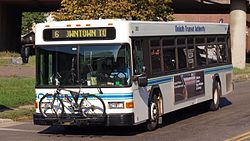Loading AI tools
Public transport agency in the Twin Ports region of Minnesota and Wisconsin From Wikipedia, the free encyclopedia
The Duluth Transit Authority (DTA) is the transit agency that provides mass transit service — currently, only buses — in the city of Duluth, Minnesota, United States. The agency also serves nearby Proctor, Minnesota, Rice Lake, Minnesota and Superior, Wisconsin, as well as the eastern edge of Hermantown, Minnesota.
 | |
 | |
| Founded | 1969 |
|---|---|
| Headquarters | 2402 W. Michigan Street |
| Locale | Duluth, Minnesota |
| Service area | Saint Louis County, Minnesota Douglas County, Wisconsin |
| Service type | bus service |
| Routes | 14 |
| Fuel type | Low Sulfur Diesel |
| Operator | First Transit[1] |
| Website | duluthtransit.com |
The organization was formed in 1969 by the Minnesota State Legislature.
In 2009, the DTA was named Transit System of the Year by the Minnesota Public Transit Association.[2]
Express service is provided during rush hours to New Duluth (2X), Proctor (3X), Lakeside (7X – PM only), Superior (16X – PM only), and Hermantown (20X). During peak hours, an average of 45 buses will be in service at any one time. The transit agency also owns three park-and-ride lots and has bike racks on the front of every bus.
As of 2009, the DTA had 6 hybrid buses in service.

In August 2023, all bus routes were removed with improved lines taking their place as part of the DTA's Better Bus Blueprint. This included the addition of two frequent BRT lines with limited stops. This list is derived from the current DTA system map.[3]
BRT (GO Lines):
Normal Routes:
Duluth Transportation Center (DTC) is the downtown hub for the Duluth transit system.
The DTC was built in February 2016,[4] replacing an existing parking ramp. The building was designed by LHB Corporation and constructed by Mortenson Construction.[5]
The DTC has eight docks for boarding buses, with space for layovers. Skyways to nearby buildings were replaced during construction, improving pedestrian access.[5]
Duluth Transit Authority is the Minnesota's third-largest transit system by ridership, after the Metro Transit and University of Minnesota Campus Shuttle systems in Minneapolis–Saint Paul.[6][7]
| Fixed route ridership[8] | Change over previous year | |
|---|---|---|
| 2005 | 2,684,804 | — |
| 2006 | 2,692,931 | |
| 2007 | 2,854,467 | |
| 2008 | 3,219,758 | |
| 2009 | 3,173,484 | |
| 2010 | 3,171,087 | |
| 2011 | 3,264,479 | |
| 2012 | 3,261,494 | |
| 2013 | 3,195,020 | |
| 2014 | 3,100,305 | |
| 2015 | 3,051,665 | |
| 2016 | 2,804,354 | |
| 2017 | 2,786,702 | |
| 2018 | 2,760,475 | |
| 2019 | 2,645,307 | |
| 2020 | 1,794,627 | |
| 2021 | 1,461,418 | |
| 2022 | 1,874,795 | |
| 2023 | 2,134,071 | |
Seamless Wikipedia browsing. On steroids.
Every time you click a link to Wikipedia, Wiktionary or Wikiquote in your browser's search results, it will show the modern Wikiwand interface.
Wikiwand extension is a five stars, simple, with minimum permission required to keep your browsing private, safe and transparent.